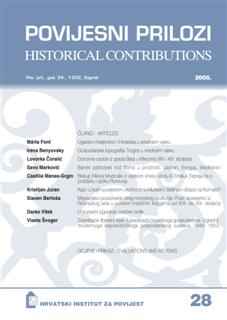Biskup Nikola Modruški o vlaškom knezu Vladu III. Drakuli-Ţepeşu te o podrijetlu i jeziku Rumunja
Bishop Nikola Modruški's notes on the Wallachian prince Vlad III Dracula-Ţepeş and Romanians' Latin origin and language
Author(s): Castillia Manea-GrginSubject(s): History
Published by: Hrvatski institut za povijest
Keywords: Vlad III Dracula-Ţepeş; Nikola Modruški; Matthias Corvinus; Wallachia; Hungary; the Ottoman Empire; fifteenth century; humanism; Romanians' origin
Summary/Abstract: In the present paper, the author deals mainly with published data about, on one hand, the fifteenth-century Wallachian prince Vlad III Dracula-Ţepeş (1448, 1456- 62, 1476) and, on the other hand, the Roman origin and language of the Romanians, contained in the historical work De bellis Gothorum (about 1473). The above-mentioned themes, according to the Croatian bishop Nikola Modruški (Nicolaus Modrussienses), are analyzed here for the first time in Croatian historiography. The author of the paper places the data offered by Modruški in the context of humanism and the growing interest for Romanians in Europe because of their role against the Ottoman Empire that was rapidly spreading in the fifteenth century. Bishop Modruški sojourned in the period 1463-64, as papal legate of Pius II, at King Matthias Corvinus' court in Buda (Hungary). During that time, Vlad III Dracula was also there (or perhaps in nearby Visegrád) as the king's prisoner. It is probable that Modruški had the opportunity to see the Wallachian prince in person. The bishop's physical description of Vlad is the only one that exists today and matches a contemporary oil portrait of Ţepeş kept in Ambras Castle (Tirol, Austria). Modruški also listened there, probably to Vlad's men, of the stories about the prince's already famous battles against the Ottomans during Sultan Mehmed II's offensive directed against Wallachia, in the summer of 1462. However, according to the Croatian bishop, King Corvinus himself told him about Dracula's alleged cruelties during his second reign (1456-62). It seems that the king was inspired by the original stories created by Transylvanian Saxons, who tried to revenge Vlad III and his armed conflicts against them. Matthias could have had his own interests in denigrating and imprisoning the Wallachian prince, because he did not help his ally during the abovementioned Ottoman offensive, although he was financially supported by the Pope and Venice. The stories that appeared during Vlad's imprisonment and told at Buda court presumably transpired into the well-known legend about Dracula -- the bloody tyrant. This legend was spread mostly by the German Stories, which were among the first best-sellers in Western Europe in the last quarter of the fifteenth and in the sixteenth centuries. Although it is not certain that Modruški allied with King Matthias in his conflict with Vlad, he can be considered one of the first European authors who (around 1463-64) came into contact with the legend about Dracula and further spread it. Unfortunately, his De bellis Gothorum is still in manuscript form today, with the exception of a section about Romanians published for the first time in 1937 by Giovanni Mercati. Nevertheless, it can be argued that the bishop's information on Vlad III had a certain influence, directly or indirectly, on his contemporaries and later authors, because it seems that even his original ideas on Romanians' Latin origin and
Journal: Povijesni prilozi
- Issue Year: 2005
- Issue No: 28
- Page Range: 106-133
- Page Count: 27
- Language: Croatian

